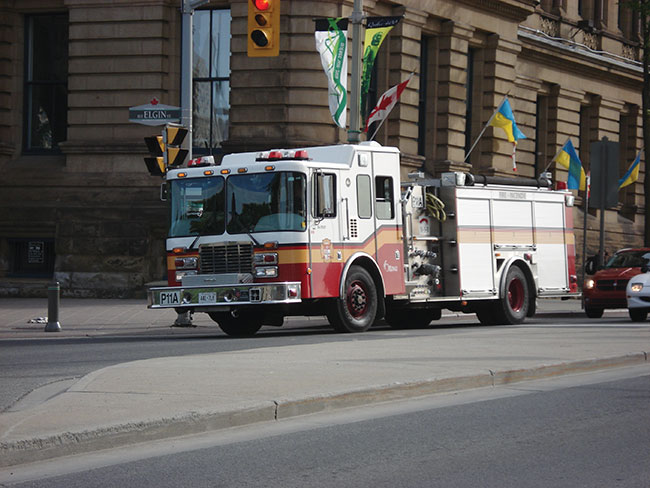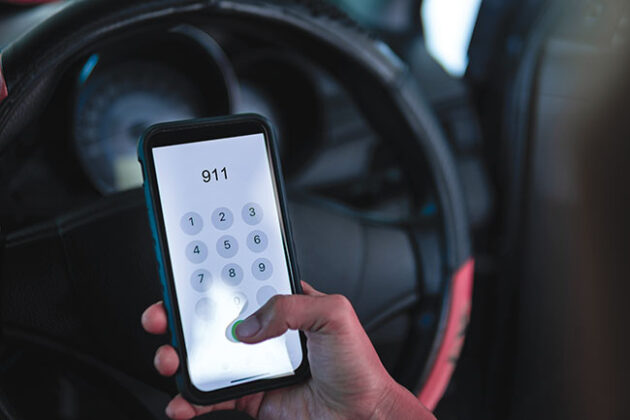
Features
Hot topics
A tiered transition
A 911 dispatch change is happening in Ontario and Fire needs a seat at the table
July 18, 2023
By Julie Fitz-Gerald
 The MPDS dispatch system will change what calls Fire goes to.
PHOTO: SEBASTIEN/ADOBE STOCK
The MPDS dispatch system will change what calls Fire goes to.
PHOTO: SEBASTIEN/ADOBE STOCK Ontario will be transitioning to a new 911 dispatch system over the next three years in an effort to provide better response times to urgent calls, however fire chiefs that have recently made the change in Peel and Halton regions are raising some alarm bells about the implementation process.
The move to Medical Priority Dispatch System (MPDS) from the previous Dispatch Priority Card Index (DPCI) is meant to ensure the most serious calls receive attention first, preventing less urgent calls from tying up ambulances while patients facing life-threatening situations are left waiting.
Under the previous DPCI system, calls were sorted into four groups, with Code 1 being a deferrable call, Code 2 a scheduled call, Code 3 a prompt call and Code 4 an urgent call with lights and sirens. The DPCI system sends ambulances in call sequence, even if a later call is more urgent. Sixty per cent of calls fell under Code 4 – many that were non-life-threatening – causing ambulance delays and Level Zeroes, meaning no ambulances were available to attend a call. This February, The Ottawa Citizen reported in a that paramedic Level Zeroes more than doubled last year, being “declared 1,819 times by the Ottawa Paramedic Service in 2022. A year earlier there had been 750 Level Zero events in the city.”
The province is hoping MPDS will change all this. MPDS is a software system that allows ambulance communications officers to determine how serious a person’s medical condition is and determine which 911 callers need help first. Through a series of questions, the communications officer determines a caller’s threat to life according to severity of symptoms. Based on responses, the caller will fall into one of six priority categories: Echo (emergent and immediately life-threatening), Delta (emergent and potentially life-threatening), Charlie (urgent and potentially life-threatening), Bravo (non-urgent, potentially serious with no immediate threat to life), Alpha and Omega, both which are non-urgent. Under the previous DPCI system, Bravo, Alpha and Omega would have all been categorized as a Code 3. MPDS is a sophisticated triage tool with 36 categories/protocols that subdivide into 1,800 sub-categories or determinants. It’s currently used in 52 countries around the world and has been in use by Toronto and Niagara for some time. The system ensures that the highest priority calls, like cardiac or respiratory arrest, heart attack, severe allergic reactions or an unconscious person receive an ambulance first. The approach makes sense. However, the implementation has proven to be a bumpy ride for some fire departments.
Oakville Fire Chief Paul Boissonneault said two of the biggest issues his department is facing with MPDS is the need for simultaneous dispatch and being able to have an ambulance on standby during active fire calls. Under the old dispatch system, fire dispatch could call the Central Ambulance Communication Centre (CACC) and have EMS on standby in case of public or firefighter injury during calls where it was prudent.
“It’s the difference in having someone ready to act versus waiting until there’s an actual emergency called. There is no standby under MPDS. That, in my mind, is a huge gap. I don’t want an incident command to have a Mayday and then we’re waiting however many minutes for the ambulance to get there,” said Boissonneault.

The MPDS system triages by 36 protocols and 1,800 determinants.
PHOTO: RELEON8211/ISTOCK PHOTO
Simultaneous dispatch, which was part of Toronto’s and Niagara’s MPDS tiered response agreements, failed in Peel region when the system was implemented in December and unfortunately was not part of Halton’s tiered response agreement at all. During a recent online learning session held by the Ontario Association of Fire Chiefs (OAFC) and led by Rob Grimwood, president of OAFC and deputy chief with Mississauga Fire and Emergency Services. Grimwood said simultaneous dispatch must be included in MPDS rollouts and he offered hope to attendees that it was in the works.
“Everyone needs this and it’s in process,” he said.
Grimwood noted in his presentation that simultaneous dispatch/notification is a bi-directional sharing of information that benefits fire and paramedics, reducing response times and eliminating the need for manual phone call updates about cautions, hazards, etc., on a particular call.
“It doesn’t add call volume and it works within your criteria through tiered response,” he explained.
As MPDS rolls out across the province, Grimwood and Boissonneault say fire departments need to ensure they have a seat at the table so they can advocate for a system that works for everyone involved. Grimwood noted that MPDS has the oversight of a medical director who is independent of Fire and Paramedic.
“In a good system, the MPDS medical director consults with both the Fire medical director and the Paramedic medical director. Be careful if a medical director is not consulting Fire and only consulting with the Paramedic medical director, because that removes Fire’s seat at the table.”
With potentially three medical directors at play (fire, paramedic and MPDS), Grimwood noted there needs to be provisions in tiered response agreements that set out how it will work.
“Niagara worked well because there was a committee that functioned well and the paramedic chief was sincerely committed.”
For Boissonneault, despite having numerous conversations and meetings to ensure up-to-date tiered response agreements with the paramedic chief and his team, he felt the quick implementation of MPDS in Oakville last December overlooked Fire’s concerns and essentially “threw them out the window.”
“I think it’s a great opportunity for the tool to be used, but there are roadblocks. Our council wants Fire there, but the paramedic chief doesn’t. We shouldn’t have to justify why our medical director and council want us at a call. We like MPDS as a tool, but there have been challenges. We are not there yet.”
Grimwood noted that Fire has historically had a big stake in the paramedic service and it’s a point that should be highlighted when hashing out tiered response agreements. He encourages Fire to come to these meetings prepared to articulate the value that Fire provides using documentation to back it up. From call reports to quality assurance documentation, bring proof of the quality service Fire provides in your region and be prepared for said call reports and patient care reports to be analyzed. “If the fire department wants to be part of medical care, we have to step up our game. The documentation process needs to be there.”
Understanding your department’s capacity is also important. Grimwood pointed out that if your department is a full-time career department with defibrillators on every truck and firefighters certified to the Emergency Medical Responder (EMR) advanced level of training, your capacity to make a difference at medical calls is much greater than a volunteer department that holds the standard first aid training certification.
“Knowledge, skills, experience and equipment determine what calls we should go to. Every department is different.”
His advice to other Ontario fire departments preparing to transition to MPDS is simple: Be at the table early, be prepared to advocate for your department, back it up with data and documentation, and show the value of what you provide.
“You need to sit down with the paramedic service, CACC and all the medical directors and go line by line as to what calls are appropriate for Fire to attend.”
When Peel region moved to MPDS, he said there was little discussion or dialogue and call volume dropped from 1,800 calls to 530 overnight. Gaps began to appear. For example, if the victim of a motor vehicle collision was deemed to have non-serious injuries/symptoms, they could be left waiting on the roadway for an ambulance for hours. Are Fire and Police expected to wait with the victim? Issues like these are now being ironed out.
“We need to get our crews back into service, not sitting on the roadside waiting for an ambulance,” explained Grimwood. As fire chiefs raise the alarm about the gaps they are seeing, the system is being tweaked and Grimwood said Peel’s fire departments have started to recover.
“Every meeting we’re getting a little more. Keep pushing for your seat at the table.”
Boissonneault is hoping for a similar ironing out in Halton.
“We’ve been advocating very hard to ensure simultaneous dispatch is another piece to the MPDS. There’s no reason for Halton not to run this. It’s not a technology issue, its simply cutting through the red tape. Fire wants to make a difference in our communities as per the level of service that our council has set. Fire does not transport patients; we are not primary care paramedics. We have significant medical training, we want to service our community, but we’re not trying to take jobs away from paramedics. We want to make a difference on scene.”
He believes that as MPDS is rolled out across the province, education among the fire service and communication to temper public expectations will be key to finding success.
“Educate yourself on what’s happening in other areas. Speak to fire chiefs who have been through it in Peel, Halton, Niagara and Toronto so you can hopefully avoid the pitfalls. It’s not just a triage tool or drop in call volume – it’s much more and it’s a huge change to what we’ve previously known. It’s not all bad. There are certainly some pieces to this that are advantageous, but there are gaps.”
Print this page
Advertisement
- B.C. expected to surpass record 2018 wildfire season for most area burned
- Record wildfire season in B.C. for area burned with almost 400 fires in the province